Terms and Conditions. A students’ exhibition at the gallery of the Academy of Fine Arts Leipzig (HGB), May 21-22, 2024
by Clio Nicastro
all photos: Katharina Bayer
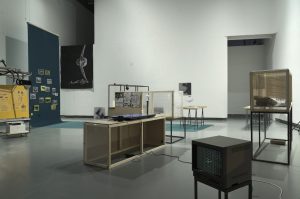
At the Academy of Fine Arts in Leipzig HGB, the project partners of Terms and Conditions. The Legal Form of Images are the photography and media class (Ines Schaber), the expanded cinema class (Clemens von Wedemeyer, Mareike Bernien), and the gallery of the academy (Ilse Lafer). Six weeks after the initial project launch of Terms and Conditions in the large white cube gallery space, the student participants used specially designed display units to present their research: a first experimental collection and interrogation, a mapping of terms, images and sounds on the relationship between law and image.
The presentation was organized according to the main interests of the working groups into three thematic areas—code of conduct, ownership, crimes and ecology—that productively resonate with each other, generating key concepts that can be helpful for further development in both the students’ artworks and the overall common research. During the presentations of the works, the students led us from position to position through the space according to the question “if they thought their work spoke to the previous one”.
There was great interest in the topic of “embodying witnessing”, exploring how human bodies, machines, and the environment can store and express the traces of events. This included examining how medicine and law intersect and influence the ways we imagine and perceive our bodies, and how our own bodies can thus become the very site of crimes and evidence of crimes against themselves (C. Bain, Hell School, lecture performance, 2024). Here the attempt is to show the ambivalence of the law, which acts as a set of tools that protects individuals while simultaneously preventing the discovery of alternative forms of justice that do not perpetuate relations of property, subservience, capitalism, extraction, and violence, here in the context of abortion, as in the US legislation discourse Roe v. Wade. The question of the human body as a witness is also explored through the difference between human vision and machine vision, a relationship with a long history that has become ever more urgent to address with the exponential growth of AI and the use of images in current wars. Some of the artworks aime to provoke reflection on these questions by displaying blurred photos produced by machine, where information is not immediately visible and legible (Mikhail Tolmachev, Waiting for Movement, photographs, 2011). This sparked discussions about what can be known in relation to what is seen or perceived, about who or what can attribute meaning to objects, about which narratives will be heard or dismissed, and about what or who is recognized as a legal subject.
One installation particularly addresses the ecological disaster in Ukraine resulting from the war, in particular the destruction of the Makhovka Dam, causing extensive flooding along the lower Dnieper river. This huge environmental catastrophe questions how it should be legally recognized as ecocide rather than merely as collateral damage—a debate that resonates with past conflicts such as the Vietnam War: who bears responsibility for environmental pollution during wartime and for how long? (Elza Gubanova, research vitrine, 2024). Hanging from the first-floor balcony of the gallery is a large image, rotated 90 degrees: a depiction of Justitia with her eyes closed. However, the meaning appears altered—she does not seem blindfolded to symbolize impartiality in interpreting the law. Instead, she appears blinded (and perhaps silenced?) as a symbol of the many injustices related to Russia’s war of aggression that have yet to be prosecuted (Anna Anufrieva, Justice of Odesa, scratched paint on construction fence tarp, 2024).
In the last years, Germany has sought to compensate for the lack of Russian gas due to the war in Ukraine and the sanctions imposed on Russia by turning to Colombian coal. Paradoxically, while Germany imports this resource from the Global South, it has announced plans to completely eliminate coal mining in its own territory by 2030as part of its cleaner energy transition. El Cerrejón, the largest open-pit coal mine in Latin America, stands in La Guajira as a symbol of this extractivism (Simón Jaramillo Vallejo, They Even Stole the Name, video and research table, 2024).
Other works focus on memorials and the (re)appropriation of memory and commemoration, especially in the former Soviet Union.The nuclear threat is at the center of this project, serving as the first chapter of a broader research initiative that reflects on its origins, primarily in the histories of the USSR and the US. It examines the causes and consequences of this phenomenon, delving into how the nuclear threat is perceived and how memories of significant historical events are both preserved and altered (Alyona Shapalova, The Stability–Instability_Stage_1, visual research scheme, 2024).
A stone slab from a public square near the Völkerschlachtdenkmal in Leipzig was removed and displayed in the exhibition to reflect on how laws and values shift after a regime change, for instance what was kept or excluded from the DDR Gesetzgebung after the German reunification (Tobias Fabek, installation 2024). Memory and absence are intertwined also in a video that follows the traces of disappearance of a set of 32 Meissen chess figures from the private porcelain collection of Gustav von Klemperer and his wife Charlotte von Klemperer. The provenance of the figures exemplifies the fate of numerous Jewish collections during the National Socialist era and is closely linked to the institutional history of the Porzellansammlung, Staatliche Kunstsammlungen Dresden SKD (Katharina Bayer, A Provenance, video, 2024).
Body scale takes another interesting shape in the ‘code of conduct’ section, where a work traces the history of the A4 paper size—DIN A4—introduced in Germany in 1922, which replaced a vast variety of other paper formats. As part of this research, the author of this piece created and displayed an A4-sized book containing their body reduced to fit this format, exploring how many A4 pages it occupies. (Tianxu Liu, Körper in DIN-Land, A4 folder, 2023). Behind the display, a slide show showed images depicting several situations that underlie some unspoken laws and codes of human behavior, highlighting the habitus and norms that influence human behavior before the law (Tianxu Liu, Dominik Schabel, Katharina Bayer, Lucia Charlotte Ott and others, Code of Conduct, slide show 2024). In the second display dedicated to “code of conduct” the issue of recognizability and visibility appear again but here the problem of tracing illegible information is inverted: how to trick and evade facial recognition tools? One work answers to this question exposing different techniques from makeup and changing hair and clothes to the more recent hyperface t-shirts (Dominik Schabel, How to Hide Your Face From an Algorithm, photo installation, 2024). The same display shows another emblematic cas: During the so-called ‘perp walk’, when inmates are transferred from prison to court, they often try to shield themselves from public scrutiny and media judgment, which can lead to premature condemnation. The exception is Donald Trump, who stands out by proudly showing his face and even raising his fist, embracing the attention rather than avoiding it (Leila Brinkmann, perp-walk #1, photo installation, 2024).
Copyright appeared as a crucial subject. A drawing/comic produced by a law graduate student (Sebastian Schicht, Chain Your Art, drawing, 2024) proposes some possible alternatives to shift the gained value back to the artist by changing the current blockchain-based contracts when deals are made between the buyer and the artist of a original art work, be it digital, painting or sculpture – without intermediaries. The paradox of the difference in value between original and copy is at the center of an ironic video work on the famous Wagenfeld Lampe, one of the most popular designs of the Weimar Bauhaus. As the costs of showing this lamp in a film or in a photo is very expensive, different strategies are used to avoid displaying the image of the “original” lamp. (Ksenia Bashmakova, title, video and object, 2024)
Located on the first floor, a performative two-part documentary film challenges German migration laws and the very notion of identity and ID documents by emphasizing the performative aspects of law and its procedures. The filmmaker creates a new German identity, playing with clichés and stereotypes, to question national borders and boundaries (Yara Saleh, Stop Over / ID, 2023). On the same screen a performance reenacted an existing performance which took place at the Meyerhold theater in Moscow more than 10 yeras ago (“Leopard Spots” by Katya Bondarenko and Tanya Gordeeva), dealing with legal issues on copyrights: based on the case of an entrepreneur who was jailed for a violation of related rights on the leopard pattern that he printed on fabrics without paying the owners (Natalia Zaitseva, Leopard Spots, performance, 2024) .
Next to these two films, a video installation on a screen is displayed on the floor, facing the ceiling, to disrupt its viewing experience. The video-essay deals with Nawalny’s case and aims to shed light on the language of law, both with its content and with its formal structures, mixing excerpts from fictional and documentary movies as well as personal videos, and news footage.The work strips the prepared speech (for example, a court speech) of its authority, allowing for a dismantling of its intended message (Daria Makarova, A Red Word Is a Lie, video installation, 2024).
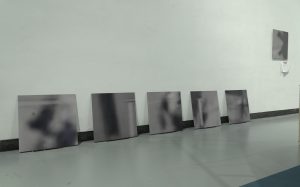 Mikhail Tolmachev, Waiting for Movement, photographs, 2011
Mikhail Tolmachev, Waiting for Movement, photographs, 2011
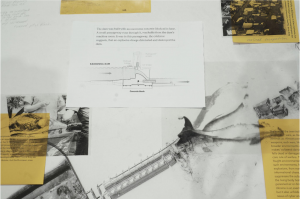
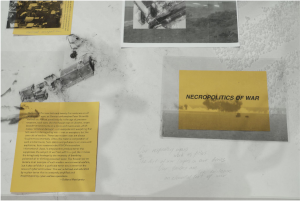 Elza Gubanova, research vitrine, 2024
Elza Gubanova, research vitrine, 2024
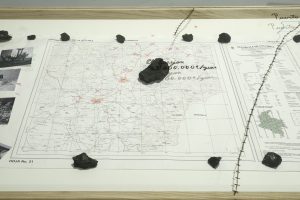
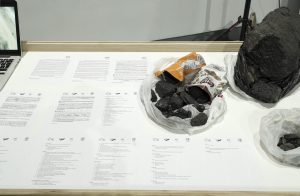 Simón Jaramillo Vallejo, They Even Stole the Name, video and research table, 2024
Simón Jaramillo Vallejo, They Even Stole the Name, video and research table, 2024
 Alyona Shapalova, The Stability–Instability_Stage_1, visual research scheme, 2024
Alyona Shapalova, The Stability–Instability_Stage_1, visual research scheme, 2024
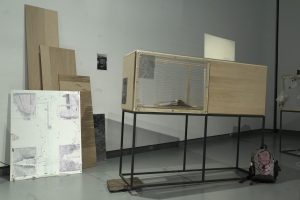
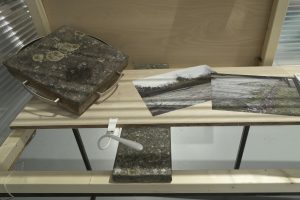 Tobias Fabek, […], installation 2024
Tobias Fabek, […], installation 2024
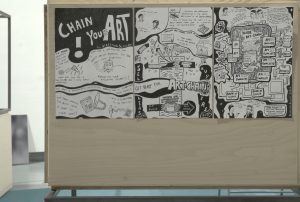 Sebastian Schicht, Chain Your Art, drawing, 2024
Sebastian Schicht, Chain Your Art, drawing, 2024
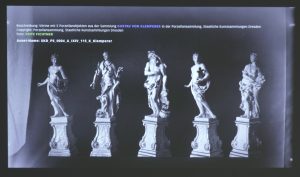 Katharina Bayer, A Provenance, video, 2024
Katharina Bayer, A Provenance, video, 2024
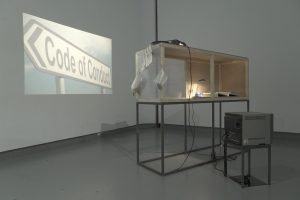 Tianxu Liu, Dominik Schabel, Katharina Bayer, Lucia Charlotte Ott and others, Code of
Tianxu Liu, Dominik Schabel, Katharina Bayer, Lucia Charlotte Ott and others, Code of
Conduct, slide show 2024
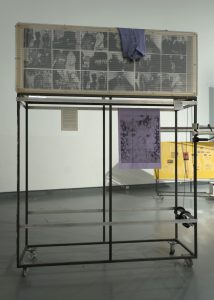 Dominik Schabel, How to Hide Your Face From an Algorithm, photo installation, 2024 (down)
Dominik Schabel, How to Hide Your Face From an Algorithm, photo installation, 2024 (down)
/Leila Brinkmann, perp-walk #1, photo installation, 2024 (up)
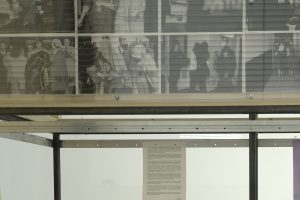 Leila Brinkmann, perp-walk #1, photo installation, 2024
Leila Brinkmann, perp-walk #1, photo installation, 2024
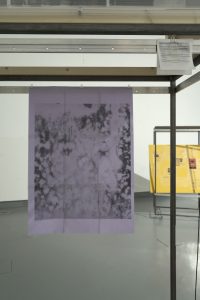 Dominik Schabel, How to Hide Your Face From an Algorithm, photo installation, 2024
Dominik Schabel, How to Hide Your Face From an Algorithm, photo installation, 2024
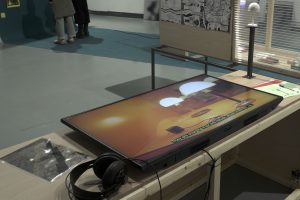 Ksenia Bashmakova, […], video and object, 2024
Ksenia Bashmakova, […], video and object, 2024
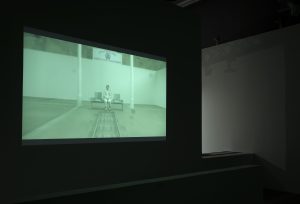 Yara Saleh, Stop Over / ID, 2023
Yara Saleh, Stop Over / ID, 2023
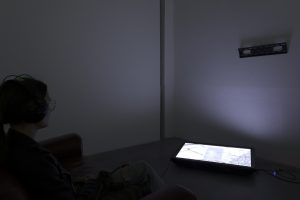 Daria Makarova, A Red Word Is a Lie, video installation, 2024
Daria Makarova, A Red Word Is a Lie, video installation, 2024
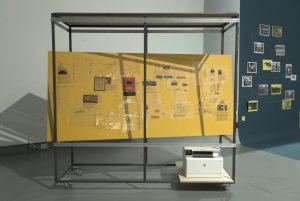 Jia-Chae Chang, 2024
Jia-Chae Chang, 2024
——
All participants:
Anna Anufrieva
C. Bain
Ksenia Bashmakova
Katharina Bayer
Johann Bärenklau
Leila Brinkmann
Jia-Chae Chang
Tobias Fabek
Elza Gubanova
Niklaus Iff
Tianxu Liu
Daria Makarova
Miljana Nikovic
Yara Saleh
Dominik Schabel
Sebastian Schicht
Karolina Sobel
Alyona Shapovalova
Mikhail Tolmachev
Malte Uchtmann
Simón Jaramillo Vallejo
Natalia Zaitseva
Lucia-Charlotte Ott